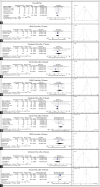Reciprocating kinematics leads to lower incidences of postoperative pain than rotary kinematics after endodontic treatment: A systematic review and meta-analysis of randomized controlled trial
- PMID: 31802813
- PMCID: PMC6873607
- DOI: 10.4103/JCD.JCD_439_18
Reciprocating kinematics leads to lower incidences of postoperative pain than rotary kinematics after endodontic treatment: A systematic review and meta-analysis of randomized controlled trial
Abstract
Background: Extrusion of infected debris into the periapical tissue has been cited as the major cause of postoperative pain, regardless of instrumentation technique.
Aim: Comprehensively review two different kinematics of instrumentation (reciprocating and rotary) and association to the postoperative pain after endodontic treatment.
Methods: Two investigators performed a systematic review with meta-analysis. MEDLINE/PubMed, Cochrane Library, and Scopus supplied relevant data from studies published until February 2018 to answer the PICO question. Primary outcome was overall postoperative pain, and the secondary outcomes were nature of the pain (mild, moderate, and severe) at 12, 24, and 48 h.
Results: Ten randomized clinical trials fulfilled eligibility criteria, and five of them were submitted in the meta-analysis. Primary outcome indicated that reciprocating system results in less postoperative pain compared to rotary system (P < 0.05). As a secondary outcome, there was no statistical difference for mild, moderate, and severe pain after 12 and 24 h using reciprocating or rotary systems (P > 0.05). However, the reciprocation system showed less severe pain after 48 h (P < 0.05).
Conclusion: Rotary motion had a negative impact on postoperative pain after endodontic treatment. Furthermore, after 48 h, more patients presented severe pain under rotary motion. More randomized clinical studies would be helpful.
Keywords: Endodontics; postoperative pain; reciprocating system; root canal therapy; rotary system.
Copyright: © 2019 Journal of Conservative Dentistry.
Conflict of interest statement
There are no conflicts of interest.
Figures


References
-
- Reese R, Aminoshariae A, Montagnese T, Mickel A. Influence of demographics on patients' receipt of endodontic therapy or implant placement. J Endod. 2015;41:470–2. - PubMed
-
- Sathorn C, Parashos P, Messer H. The prevalence of postoperative pain and flare-up in single- and multiple-visit endodontic treatment: A systematic review. Int Endod J. 2008;41:91–9. - PubMed
-
- El Mubarak AH, Abu-bakr NH, Ibrahim YE. Postoperative pain in multiple-visit and single-visit root canal treatment. J Endod. 2010;36:36–9. - PubMed
-
- Neelakantan P, Sharma S. Pain after single-visit root canal treatment with two single-file systems based on different kinematics – A prospective randomized multicenter clinical study. Clin Oral Investig. 2015;19:2211–7. - PubMed
Publication types
LinkOut - more resources
Full Text Sources
Research Materials

